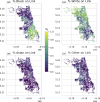The racial composition of road users, traffic citations, and police stops
- PMID: 38830097
- PMCID: PMC11181091
- DOI: 10.1073/pnas.2402547121
The racial composition of road users, traffic citations, and police stops
Abstract
This paper exploits the potential of Global Positioning System datasets sourced from mobile phones to estimate the racial composition of road users, leveraging data from their respective Census block group. The racial composition data encompasses approximately 46 million trips in the Chicago metropolitan region. The research focuses on the relationship between camera tickets and racial composition of drivers vs. police stops for traffic citations and the racial composition in these locations. Black drivers exhibit a higher likelihood of being ticketed by automated speed cameras and of being stopped for moving violations on roads, irrespective of the proportion of White drivers present. The research observes that this correlation attenuates as the proportion of White drivers on the road increases. The citation rate measured by cameras better matches the racial composition of road users on the links with cameras than do stops by police officers. This study therefore presents an important contribution to understanding racial disparities in moving violation stops, with implications for policy interventions and social justice reforms.
Keywords: Chicago, Illinois; camera enforcement; police stops; racial bias; traveler behavior.
Conflict of interest statement
Competing interests statement:The authors declare no competing interest.
Figures




References
-
- Russell K., Driving While Black: Corollary phenomena and collateral consequences. Boston Coll. Law Rev. 40, 717–731 (1998).
-
- Geiger-Oneto S., Phillips S., Driving While Black: The role of race, sex, and social status. J. Ethn. Crim. Justice 44, 709–738 (2003).
-
- Warren P., Tomaskovic-Devey D., Smith W., Zingraff M., Mason M., Driving While Black: Bias processes and racial disparity in police stops. Criminology 44, 709–738 (2006).
-
- Novak K. J., Chamlin M. B., Racial threat, suspicion, and police behavior: The impact of race and place in traffic enforcement. Crime Delinq. 58, 275–300 (2012).
-
- Rojek J., Rosenfeld R., Decker S., The influence of driver’s race on traffic stops in Missouri. Police Q. 7, 126–147 (2004).
LinkOut - more resources
Full Text Sources

